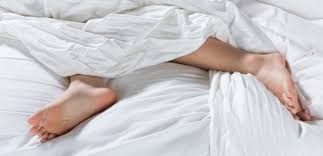
If an irresistible urge to move your legs has you kicking in your sleep, then chances are pretty good you have restless leg syndrome (RLS), a condition that affects 7 to 10 percent of Americans. Here’s what you should know.
RLS, also known as Willis-Ekbom Disease, is a nervous system problem that causes uncomfortable sensations (often described as a creepy-crawly feeling, tingling, itching, throbbing, pulling or aching) and an irresistible urge to move one or both legs while you’re sitting or lying down, and the symptoms usually get worse with age. It typically happens in the evenings or nights while resting. Moving eases the unpleasant feeling temporarily.
While RLS is not a life-threatening condition, the main problem, other than it being uncomfortable and annoying, is that it disrupts sleep, leading to daytime drowsiness, difficulty concentrating and even depression.
What exactly causes RLS is not known, but researchers suspect it could be linked to several things including iron deficiency, an imbalance of the brain chemical dopamine, and genetics – about 60 percent of people with RLS have a family member with the condition.
Treatment Options
While there’s no cure for RLS, there are things you can do to alleviate the symptoms. Depending on the severity of your case, some people turn to RLS medications like gabapentin enacarbil (Horizant), an anticonvulsant, and dopamine agonists ropinirole (Requip), rotigotine (Neupro) and pramipexole (Mirapex). But be aware that these drugs have side effects including nausea, lightheadedness, fatigue and insomnia. And, while these medications can provide short-term relief, they can also make symptoms worse in many people who use them long term.
So before turning to medication, you should consider some of the following natural RLS treatments first, which are very effective for most people.
Check your iron levels. Iron deficiency is believed to be one of the major contributors to RLS, so make an appointment with your doctor and get a blood test to check for this. If you test positive for iron deficiency, your doctor may recommend iron supplements.
Exercise: Getting moderate, regular exercise like walking, cycling, water aerobics and yoga can relieve symptoms, but overdoing it or exercising late in the day may intensify them. Daily leg stretches – include calf, hamstring, quadriceps and hip flexor stretches – are also helpful.
Check your medications: Certain drugs including anti nausea drugs, antipsychotic drugs, some antidepressants, and cold and allergy medications containing sedating antihistamines can make RLS worse. If you take any of these, ask your doctor if something else can be prescribed.
Avoid triggers: Alcohol, caffeine, nicotine and refined sugar can all make RLS symptoms worse.
Try these remedies: Soaking in a hot bathtub and massaging your legs can relieve symptoms, as can applying a hot pad and/or ice pack to your legs. Pressure can also help, so consider wearing compression socks or stockings. There’s also a new non-drug FDA approved vibrating pad on the market called Relaxis that interrupts RLS episodes and can provide relief to those who use it.
Jim Miller publishes the Savvy Senior, a nationally syndicated column that offers advice for Boomers and Seniors.
 Related Articles & Free Subscription
Related Articles & Free Subscription
IRS Introduces a Tax Form Created for Older Taxpayers
Monitoring Solutions for Loved Ones with Dementia
What Are the 2020 Income Tax Filing Requirements for Retirees?






Comment here